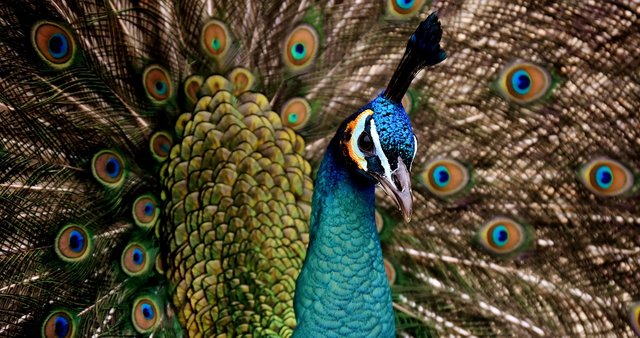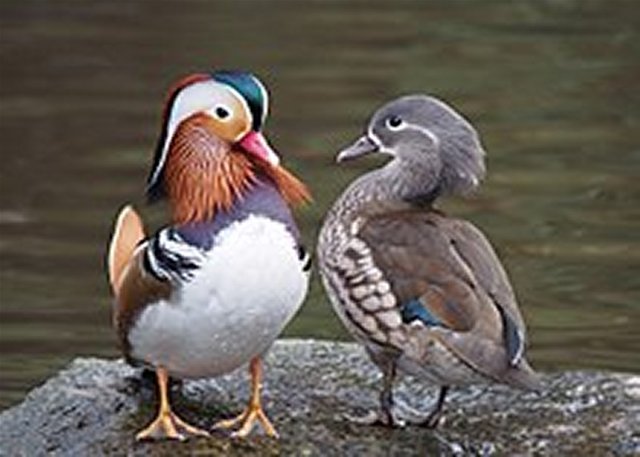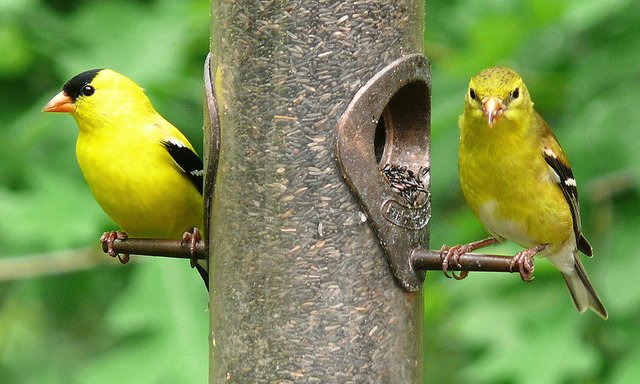The Science Behind Beautifully Coloured Feathers In Birds (Why Do Birds Have Coloured Feathers And How Did They Acquire it? — Part 1)
With more than 10,000 different species of birds adorn in beautiful diversity of colours and patterns existing[1, 2] in the world today, they are a common sight in our environs. Some of us have the beautifully coloured ones as pets in our homes; you see some special or endangered ones at zoos. And in some occasions, you are stricken by the beauty and patterns of colour in their feathers. But while you appreciate the beautiful colours and patterns of their feathers, have you ever, for a moment, spared a thought as to the real purpose behind the colours bird feathers are adorned with? Have you ever wondered how they managed to acquire such beautifully coloured feathers? Have you ever tried to find out the real science behind such colours. All these form the theme that is covered in Part 1 & 2 of this article. And I do hope you have a great time digesting the contents.

[Source: Pixabay. CC0 licensed]
Why birds have coloured feathers
Because feathers face damages upon exposure to ultraviolet radiation, and when they accumulate dirt, parasites and microbes[3]; and the fact that the brightness of feather colours matters to birds, evolution has integrated them with feather maintenance secretions — preen wax — which, among other things, keeps them waterproof, provides them with protection against feather degrading bacteria, and make them appear more deeply saturated with beautiful colour. And as if that's not enough, they still spend so much time to groom their feathers all in bid to keep them ever healthy and beautifully colourful[3].
It is even said birds are capable of discerning lots of colours than humans, including ultraviolet wavelengths; and so may appear to one another in a different way than they appear to us[2]. This means the feather colour we see when we look at birds may be quite different from what they see looking at themselves. As the bright feathers of birds catch our eye so that we base our judgment on them to say which bird is beautiful and which is ugly, so do birds rely on feather colours for many purposes, especially, in the case of males, to communicate their readiness for mating; and, in the case of females, to decide which of the males they would allow to mount them.
Male birds exhibit more beautifully colored feathers than females in order to attract them into copulation while females tend to have dull colours so that they do not elicit the attention of predators to the nest since they are mostly saddled with caring and raising the young[1, 4]. Some males who do assist the females in this responsibility tend to have much less bright feathers[4].

[Mandarin ducks male (left) and female (right), illustration showing the dramatic feather colour difference between sexesref. Source: Wikimedia commons. Author: Francis C. Franklin. CC BY-SA 3.0 licensed]
Why female birds prefer males with beautiful and colorful feathers
Female birds are more attracted to males with beautifully coloured feathers[1, 3, 4]. This is no surprise since, even among humans, everyone wants what is best for them and their offspring. That is the fact of life, and as it is found among humans, so it is among birds. Many studies have shown that there is a correlation between the feather colour and the health of male birds[4], concluding that males with beautiful well maintained plumage are generally healthier, more socially inclined, and are attracted to by more females who seek healthy genes to reproduce her offspring in order for them to have a better chance at survival[3, 4].
In a study that confirms the relationship between bird's feather colour and the state of their health, scientists separated American goldfinches into two groups. One group was given medication that would allow them to overcome common bird parasites, while the other group was not given any medication and was allowed to grow naturally. It was found that the birds which were given medicine grew more richly coloured yellow feathers while the feather colour of the group that was given no medicine wasn't as colourful. It should be noted, however, that the birds got their yellow colour from carotenoid pigment which is what gives carrots their orange colour. Birds generally do not produce carotenoids. And so in order to grow yellow feathers, they must eat plants and plant products such as berries, seeds and fruits[4].
More reasons birds have beautifully colored feathers
Mating and female preference are not the only reasons birds in general strive to keep their feathers as colorful as they can. Territorial defense is another reason. In the same American goldfinches experiment described above, scientists sought to know the essence of the black feathers male finches have on their head which female finches do not have on their heads. It was found that the black feathers were not affected by the presence or absence of parasites on the birds. To put it in another way, the healthiest males that were treated with anti-parasite medication weren't necessarily the ones with most black feathers on their heads[4].

[American goldfinches showing male in the left, and female, right. Source: Wikimedia commons. Author: Ken Thomas. Public domain image]
The researchers concluded that the female finches were only swayed by the bright yellow feathers of the males, which enable them to decide and choose healthy male finches to mate with; and that the females appeared to be unattracted to the black feathers on the heads of the male finches. Further study would confirm that male finch's black cap is related to the male territorial dominance during mating season, noting that the bigger the black cap, the stronger the male finch appears to be, and so are more capable of defending his territory against other males during mating season[4].
Within a flock, birds rely on the varied nature of their feather colours to differentiate among themselves and recognize their mates and families, thus avoiding confusion over who is who. Without this noticeable differences in their feathers, it, perhaps, would have been impossible to recognize, associate, and mate with their kinds[1].
Birds colourful feathers allows them to embark on flights and avoid dangers. The length of the distance they can cover at one stretch of flight exercise is dependent upon the weight of their feathers or wings. Feathers confers protection on birds against changing adverse abiotic conditions while their colours aids them to blend with environment in camouflage against predators[1].
Variations in feather colours enable birds to maintain stable body temperatures. Like black fabrics, black feathers attract more heat which keeps the bird warmer than the white feathers. Another reason birds have colourful feathers is to help warn off other birds from encroaching on their territories. They do this by displaying white coloured feathers on their tails whenever they feel threatened and preparing to attack or fight off an intruder[1]
Thus brings us to the end of this part; in the Part 2, we will consider in details the elements of birds' feather colours. In other words, those things that are responsible for the different beautiful feather colours birds are adorned with. Thanks for reading.
References for further reading
[1] Why do birds have such beautiful and colourful feathers
[2] How birds make colourful feathers
[3] What makes birds feathers so colourfully fabulous?
[4] Birds feathers: Why birds have coloured feathers
Yours truly,
@eurogee
Do You Blog About Science, Technology, Engineering, and Mathematics? If Yes, Patiently Read The Below Info


Join Euronation Community on Telegram and whatsapp through the below links to socialize with larger steemit community:

No Witnesses = No Steem Blockchain; If You Truly Love Here, Vote For Witnesses NOW!
Click This Link To Vote Now


Hey @eurogee :)
I grabbed my cup of coffee and headed to the computer wondering what the writing and research you mentioned you were doing yesterday was about. This is such a pleasant surprise! Despite knowing very little about them, I love birds :) So this makes for a truly pleasant read for me.
This part of your post reminded me of a saying I noted down many, many years ago
"We don't see the world as it is, we see it as we are"
Anaïs Nin
As for all the questions you raised at the beginning. Well, I guessed that evolutionary processes would answer them all. But, the info you shared here that is new to me is the reason why females have less bright feather colours (good to learn about their natural protection). And Gosh! Aren't female finches choosy :P
Thank you for these great read my dear.
I wish you a wonderful day.
Take care :*
Thanks for coming around as you promised, and how much I appreciate your visit to my page.
Yeah, female finches are very choosy.
Regards
@eurogee
Posted using Partiko Android
I know for sure that coloured feathers is for protection and for camouflage, but i never know that birds have yellow colour by eating plants and and seeds containing carotenoids. Also i don't know until now that the weight of the birds feather affects the distance they covered too.
Thanks @eurogee for this information
I am happy you learnt something anew once again thanks for always checking out my blog.
@eurogee
Posted using Partiko Android
Feeling like I just finished watching a new movie reading this. I am quite aware of the roles of feathers in mating but not in the scale that was discussed here. Certainly learnt a couple of new things. Being here always worths the energy and efforts. Keep delivering sir Euro
@sciencetech
STEM contributor
Posted using Partiko Android
Thanks @sciencetech for visiting. Appreciate this
Posted using Partiko Android
Wow this is new information sir @eurogee, i didn't know that males are more colorful than females, until know, it maKe sense just like human female are attracted to good looking male,
Have a great day my friend hopefully we can continue steeming every single day... 👍🏻😊😘
Not really like that in humans, both male and females can choose whom they associate with. In finches, only the females do so. Males don't choose....
Thanks for reading
@eurogee
Ohhhh...good additional knowledge sir eurogee.... 😊😘
Hello! a wonderful information,with amazing images! I like it.
Birds are so interesting!
Thanks to @seyiodus, this post was resteemed and highlighted in today's edition of The Daily Sneak.
Thank you for your efforts to create quality content!
Did you also know that many colors are not created chemically? In the sense that they are not pigments, but are created in other ways. Color in peacocks, for example, are created through light reflections of carefully placed photonic crystals. The only color they actually make is brown. All the rest are made from light! Here is a simple article that explains it. Butterflies and beetles are other great examples of this!
Yes I am aware of that and the part 2 of the article is bound to be released today. Thanks
Fantastic! Excited to read it!!!
Since you write scientific articles, I hope you belong to steemstem community? If not, join from the link provided in the footer above. Thanks
Thank you for the invite. I post under the #steemstem tag, but I fear that my posts are a mix of science, design, and personal reflection, so they don't usually elicit much steemstem response. My research is mainly around the effects of plants (often plant music) on humans and on the use of nature-based solutions, specifically #biomimicry, in the creation of products, processes, and systems. The latter mixes science and design, so I think it does not go as deep into the science as what is normally seen in steemstem. This is just my opinion though, and in no way a criticism. Steemstem is the tag I read first when I come to Steemit! I really appreciate the community and try to connect to it as much as I can.
I had joined the Discord months ago, but honestly, I don't use Discord enough. I did join the Telegram and Whatsapp channels you posted. I use those two much more, so it will be great to connect to more Steemians around the world.
Oh really. But discord is the best way to connect to steemstem members and leaders. And learn how to write posts that meet their standard.
You are right. I am technically there, but... I guess I prefer to comment on people's posts and learn from the people that are writing great content. I have made some super great "Steemit friends" just by commenting heavily. While Discord is probably better for some types of conversations, I prefer to spend my time reading through content here, even from the newbies, and creating connections that way. Not sure which is better, but for now it is the best I can do with my time.
really enjoyed this post. I use to to have cockatoos, that had loads of babies. From their mating ritual to how they share tending for the eggs was pretty amazing
Thanks for reading
you are most welcome